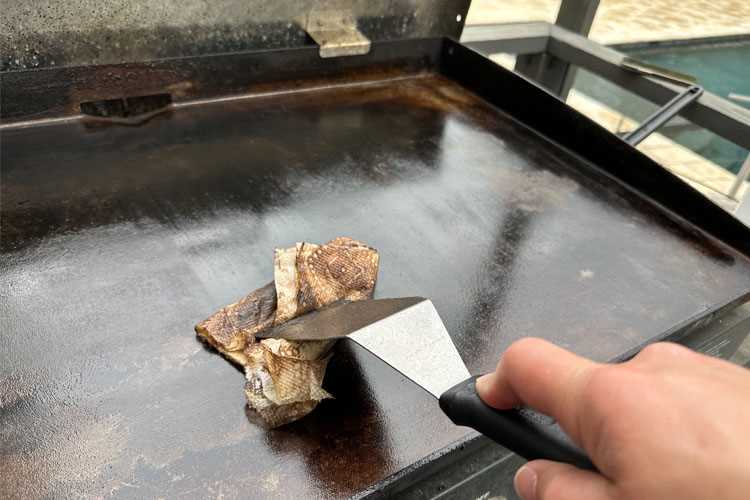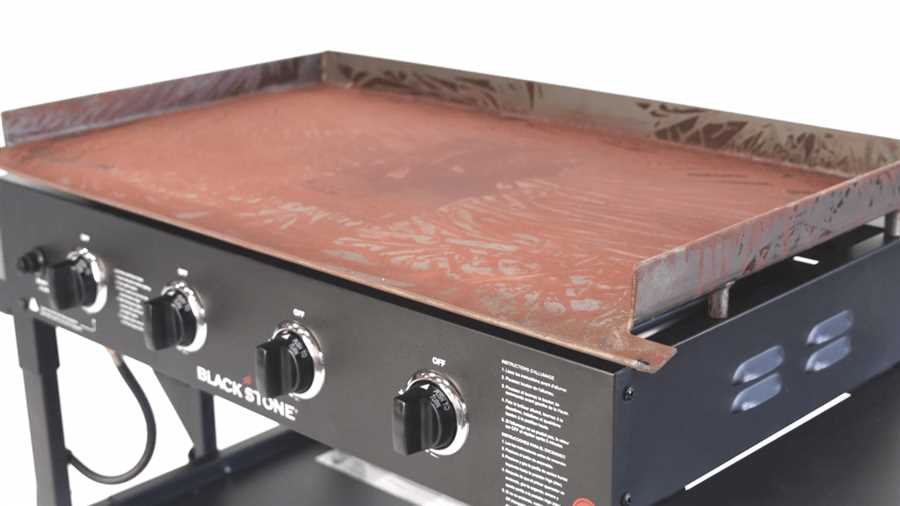







A rusty griddle can be a frustrating sight for any cooking enthusiast. The oxidation and corrosion can make you question whether it is still safe to use. However, before you throw it away or invest in a new one, it’s important to understand whether or not you can still cook on a rusty griddle.
The main concern with using a rusty griddle is the potential for the rust to contaminate the food. Rust contains iron oxide, which can be harmful if ingested in large quantities. Additionally, the taste and appearance of the food cooked on a rusty griddle may be affected.
However, not all rust is created equal. Minor surface rust that can be easily cleaned off may not pose a significant risk. The key is to thoroughly clean and season the griddle to ensure that any rust or contaminants are removed. Seasoning the griddle helps to create a protective layer that prevents further rusting and enhances the non-stick properties of the surface.
It’s important to note that if the rust on the griddle is extensive, with flakes or large areas of corrosion, it may be best to replace it. Cooking on a heavily rusted griddle could potentially expose you to harmful substances.
If you decide to cook on a rusty griddle, always exercise caution and inspect the griddle for any signs of excessive rust or damage. It’s also recommended to use cooking oils with a high smoke point to help protect the griddle surface from further deterioration. Regular maintenance and cleaning can also help prevent rust from forming in the future.
In summary, it is possible to cook on a rusty griddle, but it’s essential to assess the extent of the rust and take necessary precautions. Cleaning, seasoning, and regular maintenance can help you safely continue cooking on your griddle while minimizing the potential risks associated with rust.
Is it safe to cook on a rusty griddle?

Cooking on a rusty griddle can pose potential health risks. Rust is a form of corrosion that occurs when iron reacts with oxygen and moisture, and it can contaminate food with harmful substances.
Why is cooking on a rusty griddle unsafe?
When rust comes into contact with food, it can release iron oxide particles, which are not safe for consumption. These particles can alter the taste and appearance of food, and in some cases, they can even be toxic.
Moreover, rust can also create an uneven cooking surface. The rough texture can make it difficult to cook food evenly and increase the chances of food sticking to the griddle. This can result in undercooked or overcooked food, and potentially increase the risk of foodborne illnesses.
How to determine if a griddle is safe to cook on?
Before using a griddle, it’s important to check its condition and ensure it is safe to cook on. Here are some steps you can take:
- Inspect the griddle: Look for visible signs of rust, such as reddish-brown flakes or spots. If the griddle has significant rust, it is best to avoid cooking on it.
- Clean the griddle: If you come across minor rust spots, you can try to remove them by scrubbing the griddle with a wire brush and soapy water. Rinse thoroughly, and dry the griddle completely before using it.
- Apply cooking oil: To prevent rust from forming, it’s crucial to properly season the griddle by applying a layer of cooking oil. This helps create a protective barrier and maintain the griddle’s cooking surface.
- Store the griddle properly: After each use, ensure the griddle is dry and store it in a cool, dry place. Moisture is one of the main contributors to rust formation, so proper storage can help prevent rust from developing.
By following these steps, you can reduce the risk of cooking on a rusty griddle and ensure safe food preparation.
Potential health risks
Cooking on a rusty griddle can pose potential health risks. Rust is formed when iron or steel is exposed to moisture and oxygen for extended periods of time. The rust that forms on a griddle can contain harmful bacteria that can be transferred to the food during cooking.
When food comes into contact with the rusty surface of a griddle, there is a risk of bacteria contamination. These bacteria can cause foodborne illnesses such as salmonella or E. coli, which can lead to symptoms like diarrhea, vomiting, and stomach cramps.
Rust flakes
Another potential health risk associated with cooking on a rusty griddle is the presence of rust flakes. As the griddle continues to rust, small flakes of rust can loosen and mix with the food. Ingesting these rust flakes can cause irritation to the digestive system and may lead to gastrointestinal issues.
Toxic substances

Rust can also contain toxic substances such as lead or cadmium. These substances can leach into the food during cooking and pose a serious health risk, especially if consumed in high amounts over a long period of time. Lead poisoning, for example, can cause neurological damage and affect various organs in the body.
Therefore, it is important to ensure that your griddle is in good condition and free from rust before using it for cooking. Regular cleaning and maintenance can help prevent the formation of rust and minimize the potential health risks associated with cooking on a rusty griddle.
How to clean a rusty griddle
If your griddle has become rusty, it’s important to clean it properly before using it again. Rust can affect the taste of the food and also reduce the lifespan of your griddle. Here are some steps you can follow to clean a rusty griddle:
- Start by removing any loose rust using a wire brush. Scrub the surface of the griddle in circular motions until all loose rust is removed.
- Next, mix a solution of equal parts water and white vinegar in a spray bottle. Spray the solution onto the rusty areas of the griddle.
- Let the vinegar solution sit on the griddle for at least 10 minutes to allow it to penetrate and loosen the rust.
- After the vinegar solution has had time to work, use a scrub brush or sponge to scrub the rusty areas of the griddle. Apply some pressure while scrubbing to help remove the rust.
- Rinse the griddle thoroughly with water to remove any vinegar residue and loosened rust particles.
- Dry the griddle completely with a clean towel or allow it to air dry.
- Once the griddle is dry, apply a thin layer of cooking oil to prevent future rusting. You can use a paper towel to evenly spread the oil on the griddle surface.
By following these steps, you can effectively clean a rusty griddle and ensure it’s ready to use for your next cooking session.
Preventing rust on a griddle
When it comes to maintaining your griddle and preventing rust, a few simple steps can go a long way. Rust can not only affect the appearance of your griddle, but it can also impact the taste of the food you cook on it. Here are some tips to keep your griddle rust-free:
| Tip | Description |
|---|---|
| 1 | Season your griddle |
| 2 | Clean and dry your griddle after each use |
| 3 | Apply a light coat of oil before storage |
| 4 | Use a cover |
| 5 | Avoid using abrasive cleaners |
| 6 | Keep your griddle in a dry environment |
Seasoning your griddle involves applying a layer of oil and heating it to create a natural non-stick surface. This helps to prevent rust and makes it easier to clean. After each use, make sure to clean your griddle thoroughly and dry it completely to remove any moisture. Moisture is one of the main factors that contribute to rust formation.
Before storing your griddle, apply a light coat of oil to protect it from moisture and prevent rusting during storage. Using a cover can also help to protect your griddle from dust, dirt, and moisture. Avoid using abrasive cleaners or scouring pads that can scratch the surface of your griddle and expose it to rust.
Lastly, store your griddle in a dry environment to further prevent rust formation. Moisture and humidity can accelerate the rusting process, so keep your griddle in a place where it can stay dry.
By following these simple tips, you can keep your griddle in great shape and prevent rust from forming. A well-maintained griddle will not only last longer but also provide you with delicious meals for years to come.
Benefits of cooking on a non-rusty griddle
A non-rusty griddle offers several advantages when it comes to cooking. Here are some of the benefits:
1. Enhanced food taste
When you cook on a non-rusty griddle, you can ensure that your food tastes better. Rust can alter the flavor of the food and make it less appetizing. A non-rusty griddle allows your ingredients to cook evenly and retain their natural taste.
2. Improved cooking performance
A non-rusty griddle provides better heat distribution and retention. This means that your food will cook more evenly and faster. You will have greater control over the cooking process, allowing you to achieve the desired level of doneness.
3. Easy cleaning
Cooking on a non-rusty griddle makes cleaning a breeze. Rust can be difficult to remove, requiring extra scrubbing and potentially damaging the surface of the griddle. With a non-rusty griddle, you can simply wipe it clean after use, saving you time and effort.
4. Durability
A non-rusty griddle is more durable and long-lasting compared to a rusty one. Rust weakens the structure of the griddle, making it more prone to cracking and breaking. By cooking on a non-rusty griddle, you can ensure that your cooking surface will remain intact for a longer time.
5. Food safety
Choosing a non-rusty griddle helps ensure food safety. Rust is a sign of corrosion, and cooking on a rusty griddle can introduce harmful substances into your food. By using a non-rusty griddle, you can minimize the risk of ingesting any potentially harmful elements.
In conclusion, cooking on a non-rusty griddle offers several benefits including enhanced food taste, improved cooking performance, easy cleaning, durability, and food safety. Investing in a non-rusty griddle is a wise choice for any avid cook or professional chef looking to elevate their cooking experience.
Questions and answers
Can I use a rusty griddle to cook?
Yes, you can still use a rusty griddle to cook. However, it is important to note that cooking on a rusty surface can affect the taste and quality of your food.
Is it safe to cook on a rusty griddle?
While it is generally safe to cook on a rusty griddle, there are some risks involved. Rust can contain bacteria that may contaminate your food, so it is important to thoroughly clean and maintain your griddle to minimize these risks.
How do I clean a rusty griddle?
To clean a rusty griddle, start by scrubbing off as much rust as possible using a wire brush or steel wool. Then, apply a mixture of baking soda and water to the rusted areas and scrub again. Rinse the griddle thoroughly and dry it completely before use.
What are some tips to prevent rust on a griddle?
To prevent rust on a griddle, make sure to clean it thoroughly after each use, removing any food residue or grease. Additionally, apply a thin layer of oil or cooking spray to the griddle before storing it to help protect it from moisture.








